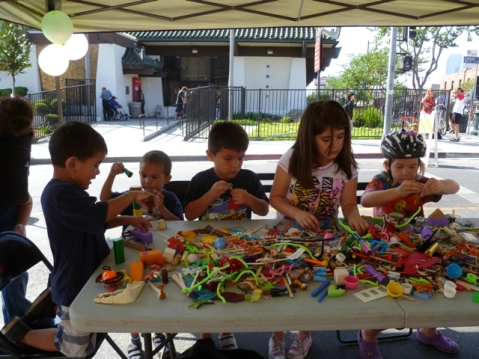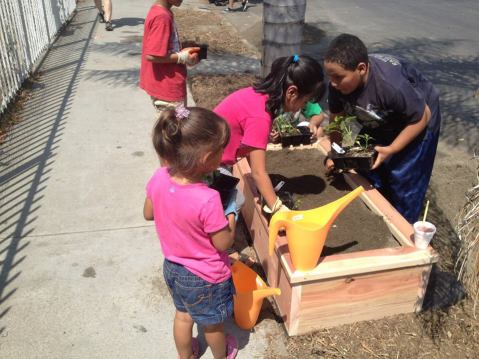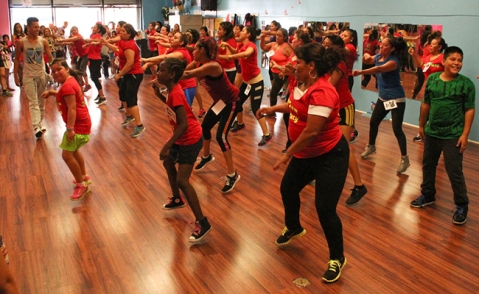LA Waves Parkway Planting Permits to Create Opportunities in Food Deserts
In my last post, I highlighted an innovative program in Toronto which brings a mobile produce market to communities who lack access to affordable and healthy food. In an effort to address healthy food access in similarly underserved neighborhoods across the US, some community residents have literally taken action into their own hands by transforming underutilized and sometimes unlikely patches of land into “guerrilla” gardens.
Trees, wildflowers, herbs, fruits and vegetables pop up in vacant lots, alleys, tree pits and even parkways (the planted strip of land between the curb and the sidewalk), providing aesthetic value, helping to oxygenated the air and clean the soil, as well as providing families with an opportunity for healthy eating. Parkways are often owned by a city but the responsibility for maintenance falls on the adjacent homeowner. These spaces have a lot of potential for urban gardening because they are right outside of a house or apartment building and are a manageable size. Some parkways go ignored, some become planted, and others become community resources.
In 2010, gardener and activist Ron Finley co-founded LA Green Grounds, a group who plants and tends gardens created in parkways and other underutilized spaces with the hope of creating a food and health revolution in underserved South Los Angeles. In 2013, Mr. Finely gave a TED Talk (above) where he discussed the inspiration for the parkway garden he created in front of his home. Mr. Finley, who grew up in South Los Angeles and raised his children there, asked the audience, “…I was wondering, how would you feel if you had no access to healthy food, if every time you walk out your door you see the ill effects that the present food system has on your neighborhood? I see wheelchairs bought and sold like used cars. I see dialysis centers popping up like Starbucks. And I figured, this has to stop. So I figured that the problem is the solution. Food is the problem and food is the solution. Plus I got tired of driving 45 minutes round trip to get an apple that wasn’t impregnated with pesticides.”
Prior to a 2013 amendment to the City’s “Residential Parkway Landscaping Guidelines”, it was illegal to plant fruits and vegetables in parkways, but due to the activism of Mr. Finley and many others, the LA City Council decided to make an exception for vegetable gardening. While this news was a step in the right direction for urban gardeners and community health advocates, the permit to plant anything other than grasses and certain shrubs, still carried a cost-prohibitive $400 price tag. But just this week, the LA City Council voted to waive the $400 fee for parkway gardens (excluding fruit trees). The City Council will still have to define the parameters of the law (regulating garden height and addressing concerns such as safe passage for pedestrians) and the ordinance will be subject to final Mayoral approval, but waiving the fee will be a significant win for advocates and paves the way to increase the opportunity for residents to bring fruits and vegetables in to their neighborhoods without the worry of fines hanging over their heads.
My Finley says: “I have witnessed my garden become a tool for the education, a tool for the transformation of my neighborhood. To change the community, you have to change the composition of the soil. We are the soil. You’d be surprised how kids are affected by this. Gardening is the most therapeutic and defiant act you can do, especially in the inner city. Plus you get strawberries.”
Zumba Boom in South LA
South Los Angeles is a 50-square-mile area within the city of LA with a lot of strengths and a lot of challenges. Many residents of this community are underserved, which means in part that they have little access to green space, safe recreational opportunities or healthy and affordable eating options. As a result, many community members struggle with obesity, heart disease and other health-related conditions in percentages disproportionate to other areas of LA with better access to resources conducive to community health. As is the case in many underserved communities, sometimes creative solutions meet opportunity and the results can be transformative.
Zumba, the Latin dance-inspired exercise craze began in Colombia in the 1990’s by Alberto “Beto” Perez. As the popularity of these classes grew internationally, the demand for Zumba teaching certifications also grew, and in response, Perez created a one-day long workshop for aspiring teachers. In the last few years almost 40 Zumba studios have found their way in to unlikely places such as parking lots, beauty parlors, swap meets, and storefronts, allowing residents to take advantage of more conveniently located exercise opportunities creatively housed in their neighborhood.
Eduardo Torijan and his wife Santa opened a studio in South LA five years ago. “We want to see people healthy and well,” he said. “That’s our goal. It’s helping people who are overweight to survive, to combat illness and know that there’s a place here for them.”
VOTE
Today, I went to the polls to let my voice be heard and when I turned in my ballot, I received this incredible LA County voting sticker. Does any city’s voting sticker represent such a diverse group of languages??
Los Angeles County has such a diverse population and it’s important to remember as planners and professionals that we are sure to include a diverse group of voices in the decision-making process.
Measure J

In 2008, Los Angeles County voters approved Measure R, giving our Metropolitan Transit Authority (MTA) $40 billlion over the next 30 years for transportation upgrades (everything from new light rail to expanded bus service to pothole repair) within the 88 cities that make up Los Angeles County. The $40 billion is funded through a half-cent transportation sales tax increase which will cost each resident around $25 per year for the next 30 years. In 2008, not only did I vote for Measure R (along with 75% of voters) but I did so enthusiastically.
Four years later, the MTA proposed a new measure on our ballots (Measure J) which would extend the tax for an additional 30 years at the cost of $90 billion. Initially, I thought that voting for Measure J would be an obvious choice, that is until I started reading the opposition to the Measure and began to assess the cumulative impacts of Measure J – thinking regionally and locally.
I am a public transportation advocate and a passionate one at that. Some of the improvements proposed in Measure J seem like they would have a positive impact but many seem negative.The problem is that we can’t be guaranteed which projects MTA will choose (or who could suffer in unforeseen ways in the process ) to put our money towards and I’m not sure I’m willing to give Metro $90 billion to carry out initiatives of their choosing.
CicLAvia’s Play Street
One of my favorite events in Los Angeles is CicLAVia, a bi-annual event that closes around 10 miles of streets to cars, filling them with bicycles, food trucks and fun. And every year it is equally as amazing to see Los Angeles’ wide boulevards filled with bicycles and pedestrians enjoying the streets and experiencing Los Angeles in an entirely new way.
The origin of CicLAvia is Ciclovía from Bogotá, Colombia. Bogotá has inspired many innovative transportation planning projects here in the US but the idea of Ciclovía or “open street” projects may be most popular. These projects can be truly transformative because they allow anyone to experience what our largest public space could be like if it prioritized people instead of cars. The Open Streets Project has created a comprehensive database of projects in almost every state in the country. From New York to Fargo to San Antonio, residents can enjoy lively open streets filled with the rush of people instead of cars
For October’s CicLAvia, some friends and I from the Living Streets Los Angeles volunteer committee, decided to take over a side street along the CicLAvia route in Los Angeles’ Chinatown and turn it in to a street filled with playful activities. Our inspiration for our play street came from the incredible work of urban planner and artist Candy Chang. Ms. Chang transforms public space through engaging participatory art projects that allow residents to use their imaginations to dream of what spaces can become.

“I Wish This Street Was…” presented by Living Streets Los Angeles at CicLAvia. Photo by Living Streets Los Angeles

Children design their ideal street at “I Wish This Street Was…” presented by Living Streets Los Angeles at CicLAvia. Photo by Living Streets Los Angeles

Photo booth fun at “I Wish This Street Was…” presented by Living Streets Los Angeles at CicLAvia. Photo by Living Streets Los Angeles

Children painting with their parents for “I Wish This Street Was…” presented by Living Streets Los Angeles at CicLAvia. Photo by Living Streets Los Angeles

Photo booth fun during “I Wish This Street Was…” presented by Living Streets Los Angeles at CicLAvia. Photo by Living Streets Los Angeles

Community members envision a new use for a street in Los Angeles (based on “I Wish This Was…” by Candy Chang). CicLAvia, Los Angeles. Photo by Living Streets Los Angeles.

Community members envision a new use for a street in Los Angeles (based on “I Wish This Was…” by Candy Chang). CicLAvia, Los Angeles. Photo by Living Streets Los Angeles.










